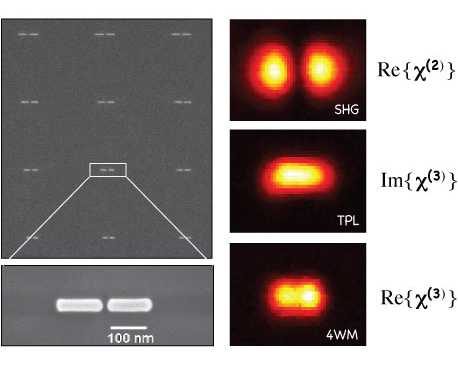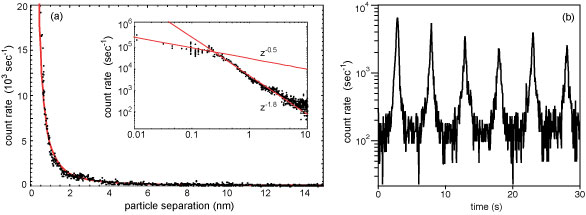Nonlinear Photonics
Noble metals such as gold and silver exhibit extremely high optical nonlinearities. For example, the third-order nonlinear susceptibility of gold is more than two orders of magnitude larger than the susceptibility of most nonlinear optical crystals, such as lithium niobate (LiNbO3).
For reasons of phase matching and absorption, metals are typically not used in nonlinear optics. Instead, nonlinear frequency conversion is generally based on anisotropic transparent crystals. However, in order for phase matching to occur the crystal needs to be hundreds of wavelengths in size, which is not compatible with the size requirements of future optoelectronic architectures. Therefore, to establish local nonlinear signal conversion in nanoscale circuits it makes sense to revisit the high nonlinearities of noble metals and to explore geometry and material related enhancement effects. Such enhancement effects make use of resonances associated with surface plasmons.
Nonlinear plasmonics is a largely unexplored territory and only a few nonlinear interactions in noble metal nanostructures have been studied so far, including second-harmonic generation (SHG), third-harmonic generation (THG), two-photon excited luminescence (TPL), and four-wave mixing (4WM). Nonlinear plasmonics makes it possible to exploit multispectral interactions in nanoscale devices and to guide and distribute the generated frequencies using plasmonic waveguides designed to work in selected frequency ranges.

We study the nonlinear response of discrete and well-defined metal nanostructures, such as nanoparticles, nanorods and particle hybrids (dimers, trimers). These structures function as optical antennas - they localize and enhance the incident fields and they facilitate the release of the nonlinear response. The goal is to identify, understand and exploit configurations that yield a high nonlinear efficiency. SHG, THG, and 4WM are coherent processes and hence the phase-sensitive interplay of local fields is very important for efficient frequency conversion. The figure above shows nonlinear frequency mixing with optical gap antennas made of gold. The structures have been fabricated by electron beam lithography. The images on the right are confocal scan images of a single gap antenna. The color scales encode the efficiency of SHG, TPL, and 4WM. The different patterns are the result of the different symmetries involved in the nonlinear process. SHG is proportional to Re{Χ(²)}, TPL to Im{Χ(³)}, and 4WM to Re{Χ(³)}.
Nonlinear signal generation in plasmonic nanostructures is highly sensitive to geometrical variations, such as the gap size of gap antennas. The figure below shows the 4WM photon count rate as a function of the separation of two 60 nm gold nanoparticles. When the interparticle distance is decreased from large separation to touching contact, the 4WM yield increases by four orders of magnitude. The reason for this dramatic enhancement lies in the shift of the localized plasmon resonance to infrared wavelengths as the dimer is formed, making one of the input wavelengths doubly resonant. Photon bursts can be generated by modulating the interparticle separation.

The high optical nonlinearities of metals bring many opportunities for nanoscale photonic devices. The ability to generate local frequency conversion with high efficiency opens the door for on-chip frequency-selective interactions across the entire visible and infrared spectrum while requiring only a single-frequency excitation. Frequency-converted fields can be employed to interact with nanoscale systems, such as single quantum dots, molecules, or ions.
Related publications:
[1] S. Palomba, H. Harutyunyan, J. Renger, R. Quidant, N. F. van Hulst and L. Novotny, ”Nonlinear plasmonics at planar metal surfaces,” Phil. Trans. R. Soc. A 369, 3497-3509 (2011).
[2] J. Renger, R. Quidant, N. Van Hulst, and L. Novotny, ”Surface enhanced nonlinear four-wave mixing,” Phys. Rev. Lett. 104, 046803 (2010).
[3] H. Harutyunyan, G. Volpe, R. Quidant and L. Novotny, ”Enhancing the nonlinear optical response using multifrequency-resonant gold-nanowire antennas,” Phys. Rev. Lett. 108, 217403 (2012).
[4] J. Renger, R. Quidant, N. Van Hulst, S. Palomba, and L. Novotny, ”Free-space excitation of propagating surface plasmon polaritons by nonlinear four-wave mixing,” Phys. Rev. Lett. 103, 266802 (2009).
[5] M. Danckwerts and L. Novotny, “Optical frequency mixing at coupled gold nanoparticles,” Phys. Rev. Lett. 98, 026104 (2007).
[6] M. R. Beversluis, A. Bouhelier, and L. Novotny, “Continuum generation from single gold nanostructures through near-field mediated intraband transitions,” Phys. Rev. B. 68, 115433 (2003).
